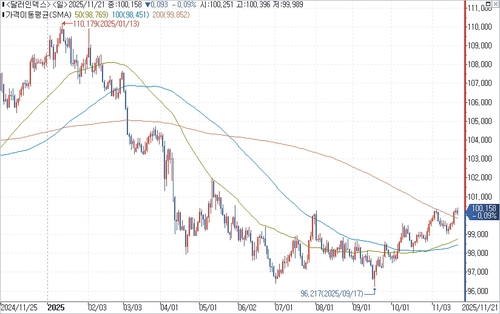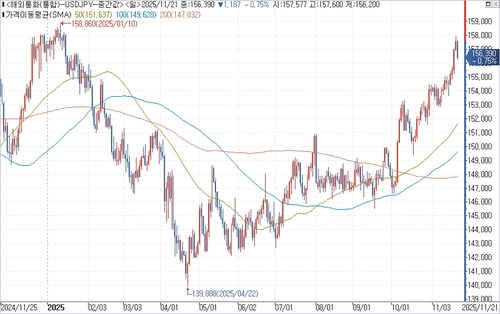(Seoul=Yonhap Infomax) Sung Jin Kim – The New York foreign exchange market is expected to focus this week (Nov. 24–28) on the possibility of a Bank of Japan (BOJ) rate hike next month.
The key question is whether the BOJ will put the brakes on yen depreciation, which has been fueled by speculation around Prime Minister Sanae Takaichi. The BOJ’s final policy meeting of the year is scheduled for Dec. 18–19.
The US Federal Reserve is increasingly expected to move toward a rate cut next month. John Williams, President of the Federal Reserve Bank of New York and widely seen as the Fed’s third most influential official, shifted market consensus toward a cut late last week.
From Saturday, Nov. 29, senior Fed officials will enter the “blackout period,” refraining from public comments on monetary policy. Unless there is another dramatic development this week, markets are likely to continue pricing in a 25bp cut at the Dec. 9–10 Federal Open Market Committee (FOMC) meeting.
The UK budget, to be released on Nov. 26, could have a significant impact on gilts and the pound. While reports suggest plans to raise income tax have been scrapped, markets will be watching for other potential tax hikes.
If the UK government’s commitment to fiscal soundness is called into question, it could weigh on advanced economy bond markets and global markets more broadly.
Dollar Trends Last Week
The US dollar index posted its first weekly gain in three weeks. Until midweek, expectations for a Fed hold and deepening yen weakness put upward pressure on the dollar.
According to Yonhap Infomax’s dollar index and cross-currency comparison (screen numbers 6400, 6443), as of Nov. 21 (local time), the dollar index (DXY), which measures the greenback against six major currencies, closed at 100.158, up 0.879 points (0.89%) from the previous week.
The dollar index rose for six consecutive sessions through the final trading day last week. This marks the first weekly close above the 100 level since mid-May.

The dollar-yen pair climbed 1.20% on the week to 156.390 yen (yen weakness against the dollar), rising for a second straight week.
Amid speculation over a large-scale economic stimulus package, the dollar-yen briefly approached the 158 level, its highest since mid-January. However, the rally lost steam after the stimulus was set at 21.3 trillion yen and the BOJ sent hawkish signals.

The euro weakened against the dollar for the first time in three weeks, with the euro-dollar rate falling 0.88% to 1.15185. The pair slipped below the 1.16 level early in the week and remained under pressure throughout.
With the yen’s relative weakness, the euro-yen rate rose 0.31% to 180.13, at one point hitting a record high of 182.02 since the euro’s inception.
The pound-dollar rate fell 0.48% to 1.31051, also down for the first time in three weeks.
The yuan weakened slightly after a week’s respite, with the offshore dollar-yuan (CNH) rate rising 0.06% to 7.1407.
Dollar Outlook This Week
US equity and bond markets will be closed on Nov. 27 for Thanksgiving. The following day, the stock market will close early at 13:00 and the bond market at 14:00 (local time).
With shortened trading sessions in equities and bonds, FX market volumes are also expected to decline, potentially increasing volatility.
Senior BOJ officials began issuing hawkish statements late last week, while Japanese FX authorities have stepped up verbal intervention.
BOJ Governor Kazuo Ueda told parliament on Nov. 21 that if the Japanese economy and inflation evolve as expected, the BOJ will continue to raise rates. The previous day, Policy Board member Junko Koeda argued for the need to normalize rates.
Board member Kazuyuki Masu, in his first media interview since taking office in July, told a local outlet at midnight on Nov. 22 (Japan time) that a rate hike decision is “drawing closer.”
This week, Policy Board member Asahi Noguchi is scheduled to speak publicly on Nov. 27. The following day, Tokyo’s November Consumer Price Index (CPI)—a leading indicator for nationwide inflation—will be released.
Due to the US government shutdown, the October jobs report and CPI have been canceled, and the November jobs report and CPI will only be released after the December FOMC. With no major economic indicators to influence the FOMC decision, last week’s market consensus may persist into this week.
No speeches by senior Fed officials are scheduled for Thanksgiving week, making Williams’ comments last week potentially the “final signal.”
US economic data this week is concentrated on Nov. 25, including ADP’s weekly private employment estimate (four-week moving average), September retail sales and producer price index (PPI), the Conference Board’s November consumer confidence index, October pending home sales, and the September Case-Shiller home price index.
September retail sales and PPI were delayed due to the shutdown. Other delayed indicators include September durable goods orders (Nov. 26) and the November Chicago PMI (Nov. 28). The Fed’s Beige Book will also be released on Nov. 26.
The Reserve Bank of New Zealand (RBNZ) is expected to cut its policy rate by 25bp at its Nov. 26 meeting. A “big cut” of 50bp, as seen last month, is considered unlikely.
sjkim@yna.co.kr
(End)
Copyright © Yonhap Infomax Unauthorized reproduction and redistribution prohibited.

